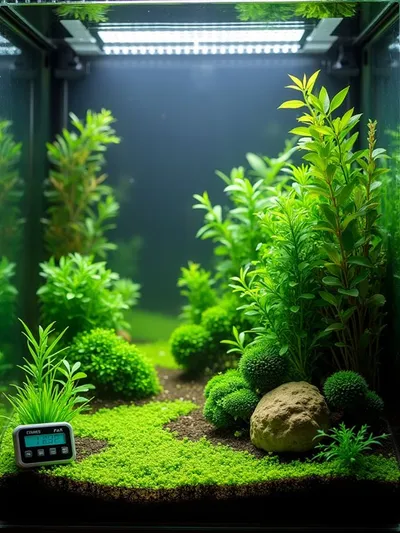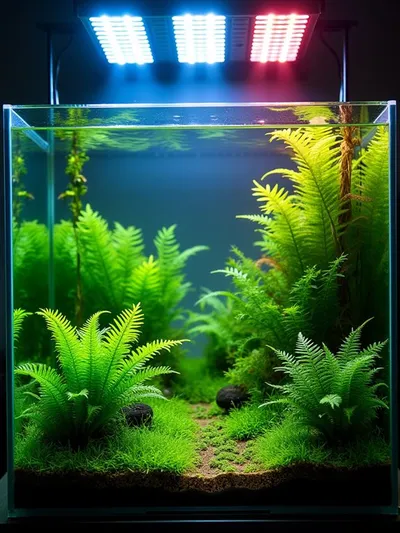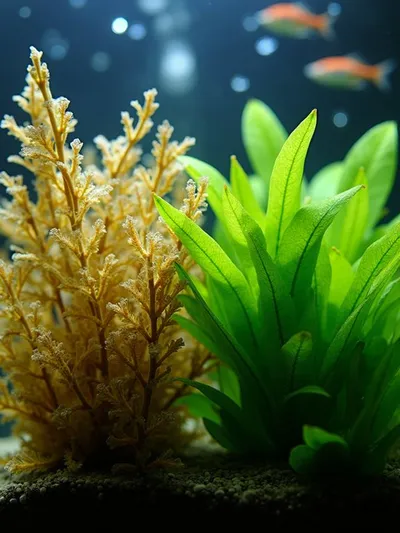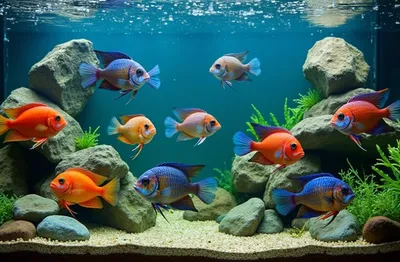For healthy aquarium plants, you’ll need proper lighting intensity (measured in PAR), appropriate spectrum (6500K is ideal), and the right duration (8-10 hours daily). Match light levels to your plants’ needs—low-light species like Anubias need 10-30 PAR, while high-light plants require 50+ PAR. Start with less intensity and shorter periods to prevent algae blooms, then adjust based on plant response. Balance your lighting with nutrients and CO2 for a thriving underwater garden.
Contents
- 1 Understanding Basic Light Terminology for Planted Tanks
- 2 Types of Aquarium Lighting Systems Explained
- 3 Matching Light Intensity to Plant Requirements
- 4 The Importance of Light Spectrum for Plant Growth
- 5 Determining the Ideal Lighting Duration for Your Setup
- 6 Budget-Friendly Lighting Options for Beginners
- 7 Common Lighting Mistakes and How to Avoid Them
- 8 Signs Your Plants Are Getting Too Much or Too Little Light
- 9 Balancing Light With Other Plant Growth Factors
- 10 Upgrading Your Lighting as Your Plant Collection Grows
- 11 Frequently Asked Questions
- 11.1 Can I Use Regular Household LED Bulbs for My Aquarium Plants?
- 11.2 How Does Water Depth Affect Light Penetration to Plants?
- 11.3 Do Floating Plants Block Too Much Light for Submerged Plants?
- 11.4 Will Colored LED Lights Promote Healthy Aquarium Plant Growth?
- 11.5 How Do I Prevent Algae Growth While Providing Enough Light?
- 12 Final Thoughts
Understanding Basic Light Terminology for Planted Tanks
When diving into the world of aquarium plants, understanding lighting terminology can seem as murky as an uncycled tank at first.
Don’t worry – we’ll clear things up together!
Light intensity (measured in PAR or lumens) determines how much energy your plants receive. It’s like food for your green friends – too little and they’ll starve, too much and they’ll burn.
Light color affects plant growth dramatically; reds and blues promote photosynthesis, while light placement impacts how evenly your aquatic garden receives illumination.
You’ll want to take into account photoperiod too – that’s how long your lights stay on each day. Most plants thrive with 8-10 hours, but it varies by species.
Types of Aquarium Lighting Systems Explained
Now that you understand the basics of aquarium lighting, let’s explore the actual systems you’ll need for your underwater garden.
LED lights dominate the market today, offering incredible energy efficiency and longevity that older systems can’t match. You’ll find LED fixtures with dimmer switches that let you control intensity for different plant species.
Fluorescent options remain popular for budget setups, though they lack the color temperature range of LEDs.
Whatever system you choose, proper lighting placement is essential—position lights to evenly distribute illumination across your aquascape. Using light reflectors dramatically improves coverage, enhancing your aquascaping techniques without additional fixtures.
When selecting your system, consider both aesthetics and practicality. The right lighting transforms simple plants into a stunning underwater masterpiece while keeping your electricity bill manageable!
Matching Light Intensity to Plant Requirements

You’ll need to match your aquarium’s light intensity to what your plants actually need, which falls into low, medium, or high categories.
Measuring light effectively with a PAR meter, rather than guessing, can save you from frustrated plant growth and algae problems.
Once you understand your plants’ requirements, you can adjust intensity levels through fixture height changes, dimmers, or adding supplemental lighting to create the perfect underwater garden.
Light Intensity Categories
Understanding the specific light requirements for different aquarium plants makes all the difference between a thriving underwater garden and a tank full of withering vegetation.
Plants typically fall into three main light intensity categories, and knowing which group your plants belong to will help you provide the perfect environment for them throughout their growth stages.
- Low light plants (10-30 PAR) – Easy beginner options like Anubias, Java Fern, and Cryptocoryne
- Medium light plants (30-50 PAR) – Popular choices including Amazon Swords, Vallisneria, and most stem plants
- High light plants (50+ PAR) – Demanding species like Dwarf Baby Tears, Red Plants, and Carpeting varieties
- Transitional plants – Species that can adapt across different light categories with varying growth rates
- Specialty plants – Unique varieties with very specific light requirements that don’t fit standard categories
Measuring Light Effectively
The art of measuring aquarium light effectively transforms guesswork into precision when caring for your underwater plants.
You’ll need proper light measurement tools to match your lighting with what your plants actually need, not just what looks bright to your eyes.
Light intensity meters, specifically PAR meters, are your best friends in this hobby. They’ll tell you exactly how much usable light is reaching different depths of your tank.
Don’t have a PAR meter? You can rent one from local fish clubs or use smartphone apps that, while not perfect, give you a starting point.
Adjusting Intensity Levels
Once you’ve measured your aquarium’s light levels, matching that intensity to what your plants actually need becomes your next mission.
Different plants have specific light requirements, and effective intensity adjustment can make the difference between thriving greenery and struggling specimens. Most modern LED fixtures include light dimming features that let you tailor brightness to your tank’s needs.
- Start low and gradually increase intensity to prevent algae blooms
- Consider purchasing a dimmer if your light doesn’t include built-in adjustment
- Watch your plants for signs they need more light (leggy growth, pale leaves)
- Reduce intensity if you notice excessive algae developing
- Remember that floating plants need higher intensity than those at the bottom
Experiment with different settings until you find the sweet spot where your plants flourish without unwanted algae taking over!
The Importance of Light Spectrum for Plant Growth

When setting up your aquarium lighting, you’ll need to understand that different light spectrums affect plant growth differently, with red and blue wavelengths being particularly important for photosynthesis.
You might notice many hobbyists discussing PAR (Photosynthetically Active Radiation), which measures useful light for plants, rather than Kelvin values that simply indicate color temperature.
Choosing the right spectrum can make the difference between lush, vibrant plants and struggling ones, so it’s worth taking the time to match your lighting to your plants’ specific needs.
Red vs. Blue Light
Understanding light spectrum can dramatically improve your aquarium plants’ health and growth. Different wavelengths serve unique purposes, with red and blue light playing vital roles in your underwater garden’s success.
- Red light benefits include stimulating flowering and promoting robust stem growth in many aquatic plants.
- Blue light effects focus on vegetative growth, helping plants develop stronger leaves and compact structures.
- Your plants typically need more blue light during their early growth stages.
- Red wavelengths become more important as plants mature and begin reproductive phases.
- A balanced combination of both wavelengths creates ideal conditions for most aquarium plants.
You’ll notice that plants respond differently to these light variations, so don’t be afraid to experiment with your lighting setup to find what works best for your specific aquatic garden.
PAR vs. Kelvin Values
While red and blue light play specific roles in plant development, measuring light effectively requires understanding two key metrics: PAR and Kelvin values.
PAR (Photosynthetically Active Radiation) measures the light that plants actually use for photosynthesis, ranging from 400-700nm wavelengths. It’s what your plants care about, not what looks brightest to your eyes! Higher PAR values mean more usable light reaching your aquatic plants, affecting their growth rate directly.
Kelvin, meanwhile, describes light quality or color temperature. Lower values (2700K-3000K) produce warm, yellowish light, while higher values (6500K-10000K) create cooler, bluer tones.
The sweet spot for most aquarium plants is 6500K, which simulates natural daylight and promotes even light distribution throughout your tank.
Determining the Ideal Lighting Duration for Your Setup
Although plants need light to thrive, they also require periods of darkness to complete their natural metabolic processes. Finding the ideal light schedule for your aquarium plants balances their growth needs while preventing algae overgrowth.
Most planted tanks do well with 8-10 hours of light daily, but your specific setup might need adjustments.
- Start with 8 hours daily and monitor plant growth and algae development
- Use a timer to maintain consistent lighting periods (your plants love routine!)
- Consider seasonal lighting adjustments to mimic natural conditions
- Reduce duration if algae becomes problematic (even 6 hours can work!)
- Gradually increase lighting time for demanding plants like carpeting species
Budget-Friendly Lighting Options for Beginners

Because getting started with aquarium plants shouldn’t empty your wallet, you’ll be happy to know there are plenty of affordable lighting options that work beautifully for beginners.
Affordable LED strips are your best friend when you’re just starting out. They provide sufficient light for low to medium-light plants while keeping your electricity bill manageable. You’ll find complete kits starting around $20-30 that include everything you need to illuminate a standard tank.
Don’t overlook DIY lighting solutions, either! You can create custom setups using clamp lamps with daylight bulbs or repurpose desk lamps you already own.
Many hobbyists have successfully grown beautiful plants using these improvised methods. The key is choosing the right bulb color temperature (around 6500K) to promote healthy plant growth without encouraging algae blooms.
Common Lighting Mistakes and How to Avoid Them
Now that you’ve set up your budget-friendly lights, let’s explore the pitfalls many aquarists stumble into when lighting their planted tanks.
Understanding these common misconceptions will save you time and frustration as you develop your underwater garden.
- Leaving lights on 24/7, thinking plants need constant light (they don’t—they need rest periods too!)
- Placing tanks in direct sunlight, causing excessive algae growth
- Using incorrect color temperature bulbs that don’t support photosynthesis
- Installing lights too high above the water surface, reducing intensity
- Skipping regular maintenance and cleaning of light fixtures
When you notice unusual plant growth or stubborn algae issues, use these troubleshooting tips: adjust your lighting duration, clean bulbs regularly, and match light intensity to your specific plant species.
Signs Your Plants Are Getting Too Much or Too Little Light

Identifying the right light balance for your aquarium plants can feel like detective work, but your green friends provide clear clues about their lighting needs.
When plants receive too much light, you’ll notice light burn—yellowing or browning leaf edges that eventually turn crispy. Stems may become stunted, and delicate plants might develop bleached patches. Time to dial down that intensity!
Too much light creates crispy, yellowed edges and stunted growth—nature’s way of saying “enough already!”
Conversely, insufficient light creates telltale shadow effects as plants desperately stretch toward light sources. You’ll see leggy, elongated stems with increasing space between leaves. Colors fade from vibrant greens to pale yellows, and slow growth becomes the norm. New leaves might emerge smaller than older ones.
Watch for these signals and adjust accordingly—your plants will thank you with lush, healthy growth!
Balancing Light With Other Plant Growth Factors
While your lighting might be perfect, you’ll need to balance it with proper nutrients for your plants to thrive.
Your CO2 levels work hand-in-hand with light intensity, creating either a growth boost or potential algae issues when they’re out of sync.
Finding the right light duration, typically 8-10 hours daily, completes this balancing act, giving your aquatic plants just what they need without encouraging unwanted algae growth.
Nutrient Uptake Connection
As light intensity increases in your aquarium, so too does your plants’ demand for essential nutrients.
Think of light as the engine that powers nutrient absorption—when you rev up that engine with brighter lights, you’re also increasing your plants’ appetite! Without proper nutrient balance, even perfect lighting won’t lead to thriving plant health.
- Nitrogen fuels leaf growth and turns pale plants into lush green beauties
- Iron prevents yellowing leaves and supports vibrant coloration
- Phosphorus promotes strong root development and flowering
- Potassium regulates water movement and strengthens stems
- Carbon (from CO2) serves as the building block for all plant tissue
You’ll need to adjust fertilization as you increase lighting.
CO2 Levels Matter
Those hungry plants we discussed don’t just need nutrients—they’re equally thirsty for carbon dioxide! When you crank up your lighting without providing adequate CO2, you’re fundamentally revving an engine without enough fuel. Your plants will struggle, and algae will throw a party in your tank.
During photosynthesis, plant respiration increases with light intensity, demanding more carbon dioxide. In low-tech setups, you’ll want moderate lighting to match the natural CO2 levels.
But if you’re ready to level up, CO2 enrichment can transform your aquascape from merely surviving to absolutely thriving.
Remember this golden rule: light, nutrients, and CO2 must stay in balance. Think of them as a trio of musicians—when they perform in harmony, your underwater garden creates a masterpiece. When they don’t, it’s just noise.
Light Duration Balance
Finding the sweet spot for how long your lights should be on represents one of the most essential balancing acts in aquarium keeping. Your light schedule directly impacts plant growth, algae development, and the overall ecosystem health.
Most aquariums thrive with 8-10 hours of light daily, but you’ll need to make seasonal adjustments based on your specific plants and tank conditions.
- Too little light (under 6 hours) leaves plants struggling to photosynthesize efficiently
- Too much light (over 12 hours) often triggers aggressive algae growth
- Morning-to-evening schedules mimic natural conditions plants evolved with
- Dimming periods at dawn and dusk reduce stress for fish and plants alike
- Seasonal adjustments of ±1-2 hours can boost plant health during winter months
Upgrading Your Lighting as Your Plant Collection Grows
When your aquatic plant obsession inevitably takes over, you’ll need lighting that can keep up with your growing collection. As you shift from easy-growing Anubias to demanding red plants, your basic LED strip won’t cut it anymore.
Consider upgrading fixtures to systems with adjustable intensity and spectrum controls. Many modern LEDs allow you to customize lighting schedules that mimic natural sunrise and sunset, enhancing aesthetics while promoting healthier growth.
You don’t need to break the bank either—start with a mid-range upgrade that offers more PAR output and better coverage.
Remember that proper lighting isn’t just about plant health—it transforms your aquarium into a stunning focal point in your home.
When friends ask about your gorgeous underwater garden, you’ll smile knowing your lighting upgrade made all the difference.
Frequently Asked Questions
Can I Use Regular Household LED Bulbs for My Aquarium Plants?
No, you can’t use regular household LED bulbs effectively. They don’t provide the right light spectrum for photosynthesis. You’ll need specific aquarium LED bulb types designed with the proper spectrum for plant growth.
How Does Water Depth Affect Light Penetration to Plants?
Water depth affects light penetration considerably. As depth increases, you’ll notice more light absorption occurs, reducing intensity for your plants. Water clarity also impacts this—cleaner water allows more light to reach deeper areas.
Do Floating Plants Block Too Much Light for Submerged Plants?
Yes, floating plants can block light for submerged plants. You’ll need to balance your floating plant types and maintain appropriate light intensity. Consider partial coverage or choosing less dense floaters if your underwater plants struggle.
Will Colored LED Lights Promote Healthy Aquarium Plant Growth?
You’ll want to avoid colored LED lights for plant growth. Plants need specific light spectrum wavelengths, not just colored light effects. White LEDs with proper red and blue components will promote healthier aquarium plant growth.
How Do I Prevent Algae Growth While Providing Enough Light?
You’ll control algae by limiting light duration to 8-10 hours daily. Use a timer, add floating plants, maintain proper nutrients, and clean regularly. Too much light directly causes algae overgrowth in your tank.
Final Thoughts
You’ve now got all the tools you need to create a thriving underwater garden! Remember, proper lighting isn’t just about brightness—it’s about finding the right balance of intensity, spectrum, and duration for your specific plants. Don’t worry if you make mistakes; even experienced aquarists adjust their setups regularly. As your confidence grows, you’ll develop an intuitive understanding of what your aquatic plants need to flourish. Happy planting!











